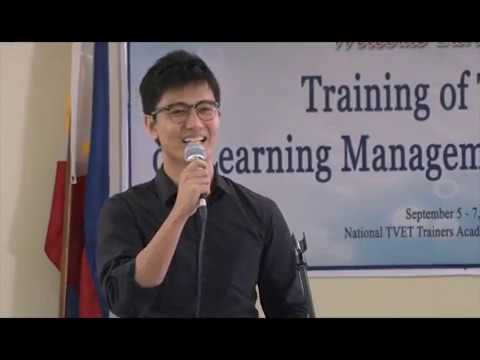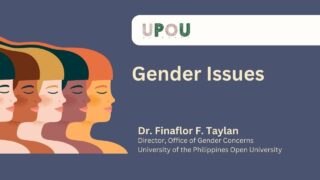Teaching Philippine Literature in English | Dr. Gemino Abad
Teaching Philippine Literature in English
Dr. Gemino Abad
In this talk, I used the word poet as a figure for the writer as literary artist and the word poem or poetry as the generic term for all literary works. I also distinguish between communication and expression. In communication, one conveys what one thinks and feels at the moment of speech with other speakers. In expression, one shapes the language to one’s own perception or intuition about some aspect or feature of reality, whether that reality has actually been lived or has only been imagined. Literature or “imaginative writing” is the field of expression. Its subject or theme is our humanity, our experience as human.
Literature itself—like history, culture and language—is always in flux. What we usually call fiction, poem, play or creative non-fiction or essay are only possible forms of expression, shape or wrought from a given historical language. If so, those forms already secrete the rules and criteria of their possibilities. The writer, as [the] literary artist, is always in quest of other forms of expression. The imagination has infinite possibility. Whatever kind or type a literary work is, it enacts what we are as human beings—what, in our individual and in our common history, we have become and maybe becoming. A symbolic or imaginative enactment, literary works are re-inventions of the imagination. We ourselves create the meanings that help us live. We have, then, on the one hand, what we call “our world,” our reality: Nature, people and their affairs; and on the other hand, language. The human being alone, it seems, is conscious of death and, so, he has this great yearning for this world, this life. He longs for the world and the living to be the meaningful word incarnate. This impels him to translate, to carry the world over the language, to ferry across the words of the language the wonder of nature, the miracle of living. It is no accident [that] we speak of language as a “tongue”. The figure suggests that we would savor, with words and words, the joy of living to the full.
Any language, in fact, is by itself already translation from Latin trans + ferre: “to carry across”. Any language is a way of perceiving in a given culture during a given historical period. Writing also is essentially translation, we ferry across our words whether they are indigenous or adopted. Those thoughts and feelings we have not till then found our expression or which need again to be expressed in a new form, that they perhaps may still live after our living.
What is expressed, through words and the images or myths that they are made to evoke, is an insight into our humanity. That insight is the luminance of thought which no concept or idea conveys. A radiance of feeling which no thought catches. If this is so, then language is our first fiction, and it’s working—it’s being wrought into poem or story—a second, by which our humanity is, as it were, again created. Fiction I said, but no less real because it is the imagination which makes real to the mind what it abstracts from our experience. As teachers of English, we want to privilege Filipino literature wrought from English as models of good writing precisely because, one, the culture and experience from which these points arise are our own history as a people. And two, this poem show how English as a medium of expression operates to shape our own thoughts and feelings as Filipinos.
By way of the imagination, our poets have cleared a clearing of our own within that adopted language called English. Even as, in our literary history, our writers have done so with Spanish. It may be remarked that the Filipino experience can be expressed only in Filipino—that is to say, in Tagalog, Sugbuanon, Iloko, Hiligaynon—but that is to misconceive language. Language shapes the things that it expresses. Language is, as a given historical medium or cultural artifact, language itself is already a fixed way of looking at reality therefore creating a version of that reality. Of course, as the speakers and the readers outlook changes, language also changes. Be it English or Tagalog, language is always already a partial representation of reality, an interpretation of the world and human affairs shared by the community of the language’s speakers. But the poet, like most everyone, sees things through his own sensibility and imagination, however his own self might also have been shaped by changes in his own time and culture. He may see things differently from the way of looking that in years in the language he employs. In that case, he must work the language to make it express his own seeing and feeling.
The workshop approach in creative writing may be one effective way of teaching English through models of excellent writing by Filipino writers. Here, the students are encouraged to express themselves imaginatively by probing their own experiences and exploring the resources and experimenting with the possibilities of English as a linguistic medium. This workshop approach assumes that the very act of writing itself recreates the language. The teacher therefore must show how this takes place. He takes, as a working hypothesis an interpretation, an end or goal that the writer has set out to accomplish. So he asks, “what is the poem about?”—that is to say, its paksa: subject or theme. “What is the poem’s point or insight—its saysay, meaning: significance?” Next, he asks about the poems final end or goal: “Did the poem succeed in enforcing that theme? In expressing that insight?” The story or poem itself shows how the language has been employed and deployed to achieve its effect on the sensitive reader. That effect we call “dating”. The poem has a rhyme. The intellectual or emotional force or energy of the poem by which the poems end is achieved. The teachers purpose here is to make the student aware of linguistic and rhetorical resources and their unlimited possibilities and therefore enhance the students’ sense for language. This sense for language is the basic poetic sense which is nourished by the love of reading and is the foundation of proficiency in any language.
The workshop approach requires close analytical reading of the literary text to open it. For as you read, you are not a passive consumer of a product, you’re an active producer of meaning. You enter imaginatively the human experience that the poem depicts. In the poems world, you are engaged with a way of thinking and feeling. You see and feel the way the poems’ speaker or the characters in the story see and feel, so that at the end, when you make an assessment—a judgement—about the literary or poems imagined experience, you have first lived as if it were another life. You have first considered the other imaginary person’s viewpoint before you favor, as it may happen, your own interpretation. By cultivating this sensitivity as one reads, one can begin to appreciate what the writer has accomplished—all that he has done with the sole means of language.
Let us take two poems by Edith L. Tiempo: “Lament for the Littlest Fellow” and the poem “Bonsai”.
“Lament for the Littlest Fellow”
The littlest fellow was a marmoset.
He held the bars and blinked his old man’s eyes.
You said he knew us and took my arm and set
My fingers round the bars, with coaxing mimicries
Of squeak and twitter. “Now he thinks you are another marmoset in a cage.”
A proud denial set you to laughing, shutting back a question far
Into my mind something, enormous and final.
The question was unasked but there is an answer.
Sometimes in your sleeping face upon the pillow,
I would catch our own little truant unaware;
He had fled from our pain and the dark room of our rage,
but I would snatch him back from yesterday and tomorrow.
You wake and I bruise my hands on the living cage.
That was in 1950 from Sands and Coral
Now, the next poem—“Bonsai”
All that I love
I fold over once
And once again
And keep in a box or
A slit in a hollow post
Or in my shoe .
All that I love?
Why, yes, but for the moment—
And for all time, both.
Something that folds and keeps easy,
Son’s note or Dad’s one gaudy tie,
A roto picture of a young queen,
a blue Indian shawl, even
A money bill.
It’s utter sublimation,
A feat, this hearts control
Moment to moment
To scale all love down
To a cupped hand’s size,
Till seashells are broken pieces
From God’s own bright teeth,
And life and love are real
Things you can run and
Breathless hand over
To the merest child.
That was in 1972 in Focus magazine.
Now, in the first poem, what the question is and what exactly the answer to it—both “something enormous and final”—we would have to infer both from the imagery and the metaphor that subtly limb or delineate the human situation. The soul metaphor is the marmoset in a cage, a monkey—a monkey whose name etymologically suggests a “grotesque mumbling figure”. When the husband mocks his wife, the poem’s speaker, as resembling a marmoset which she proudly denies, the resemblance had already been subtly fixed by her own perception of the marmoset as “the littlest fellow” with “his old man’s eyes” which marks the animal as human. The husband taunts his wife, enforcing the resemblance by setting her fingers round the bars as to simulate a prison cell for her and mimicking all the while a marmoset “squeak and twitter”. All male banter or monkey business for a moment’s merriment, but it provokes in the wife a realization instantly suppressed because it is dark, “something enormous and final”.
For nights afterwards, whenever the wife would catch the image—marmoset—in her husband’s sleeping face, she would only call it “our own little truant,” as though to make light of it. Since in that past moment of truancy and banter in the zoo, she had repressed a dark intuition. The image had fled from our pain in the dark room of our rage. In the poem’s human situation, bedroom, our sight of intimacy, has become a variation upon cage, and yet, she “would snatch him back”—the marmoset—“from yesterday and tomorrow”, because the image held the truth: “you wake and I bruise my hands on the living cage”. At the poem’s end, we might also ask, “why in the title of the poem? Why lament for?” Is it because the truth is constantly denied so that its enormity, “the living cage,” might be lightened. But lightened, indeed, it is, in a later poem—a later moment of enlightenment, where the image of the poems insight appears only in the poem’s title.
“Bonsai.” Well, of course, assuming that the speaker in “Lament” and the speaker in “Bonsai” is the same wife. The poem “Bonsai” is, as it were a free form because that moment, where all love is gathered, is “all time”. In fact, it isn’t so much image of bonsai as idea and feeling which the poems words enforce. Box or slit in a hollow post or shoe—it isn’t the image, such as the marmoset in his cage. Which motivates or propels the poem but rather, the idea of souvenir or memento, by which one cherishes and nurtures “life and love as real”—as real as any material thing like “a blue Indian shawl”.
This calls to mind Eduardo Galeano’s wondrous epigraph to his Book of Embraces in 1989: “Recordar:” he says, “to remember; from Latin re-cordis, to pass through the heart.” So, be it “Son’s note or Dad’s one gaudy tie” or even the most ordinary thing like “a money bill.” The revelation or insight about those mementors is the point, and it would be the highest art to state it quite simply, without any rhetoric of irony and ambiguity so cherished in the “New Critical” mode:
It’s utter sublimation
A feat, this heart’s control
Moment-to-moment
To scale all love down
To a cupped hand’s size
Yet, the irony and the paradox are there, in the very aptness of the words “scale” and “cupped hand,” so carefully chosen so that life and love as real things appear all the more magnificent.
“Till seashells are broken pieces,” says the poet “From God’s own bright teeth,”
Ah, this, for me, is the most remarkable feat in the poem’s making. It is the poet had said “for the moment—And for all time, both”—this keeping of mementos, this folding over and scaling down to keep easy and cherished. So then, “till seashells” encompasses all time and, by invoking God, suggests a divinity in that simple yet mysterious affection which sustains life and love as real. The image of seashells glinting on a sunny beach evokes brightness and cheer. And so fulfills what the poet speaks of as “hearts control.”
Ah, but there is more. Seashells are broken pieces like souvenirs—that is to say, they are broken off as it were from those happy moments where “life and love are real”; then, indeed for souvenirs are deeply cherished, there are things—they are as things that are very light. So that “you can run and / Breathless hand over / To the merest child”. That truly is the very sign that it is real, for a child needs no further proof of love than love.
Yeah, okay. Thank you.
How useful was this resource?
Click on a star to rate it!
Average rating 4.6 / 5. Vote count: 5
No votes so far! Be the first to rate this post.
We are sorry that this post was not useful for you!
Let us improve this post!
Tell us how we can improve this post?




























1 Comment